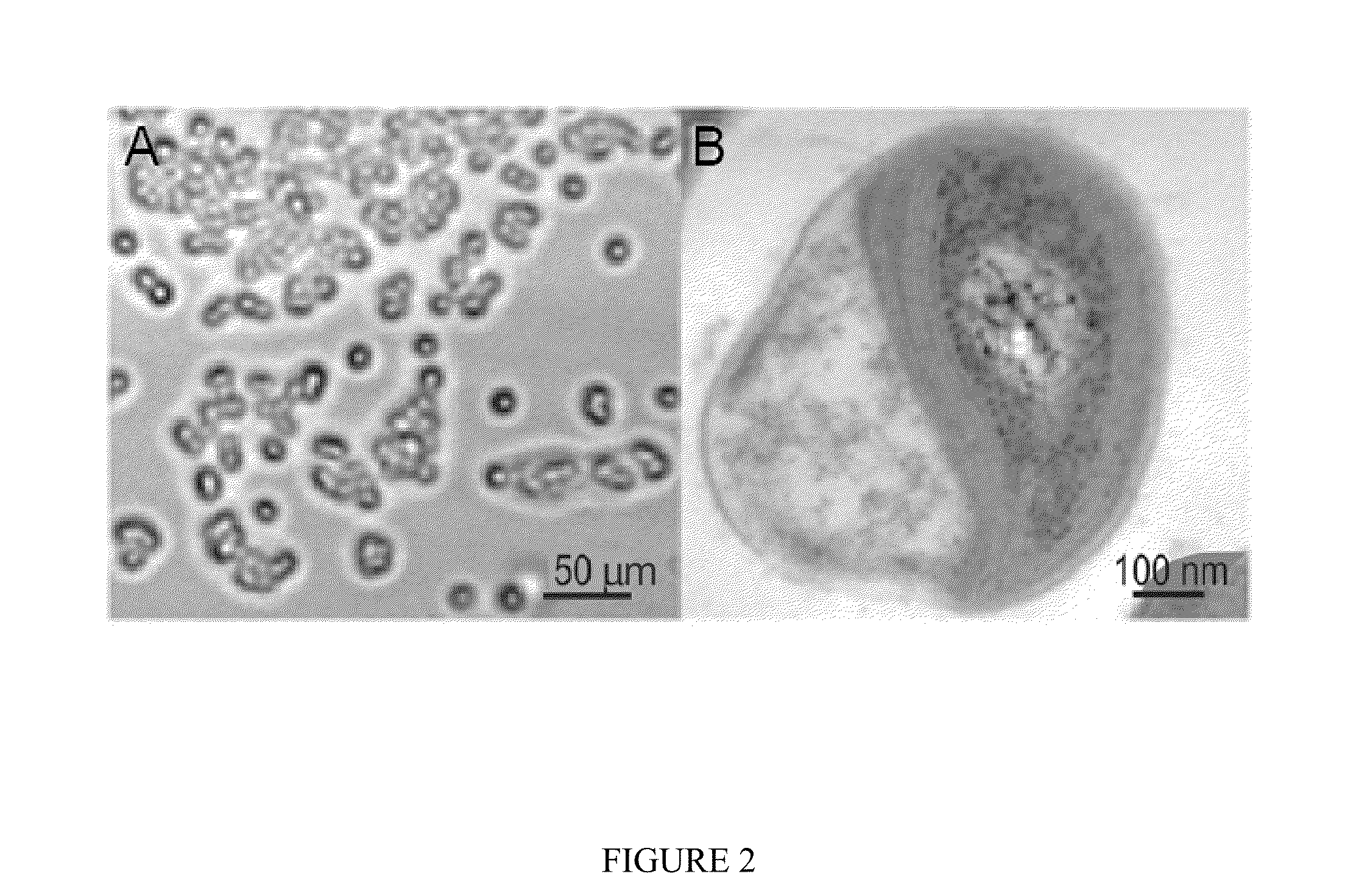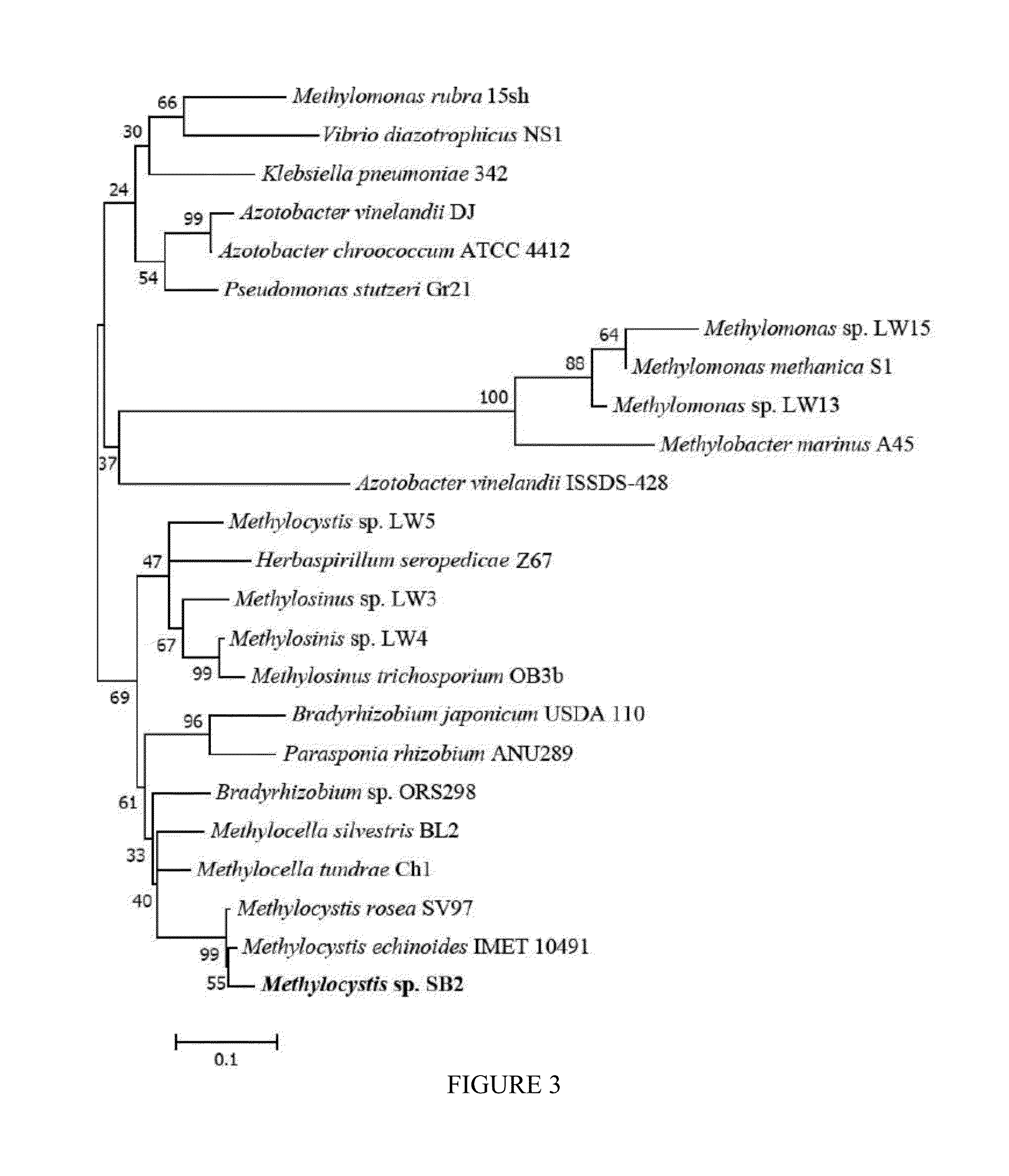Methylocystis strain SB2 materials and methods
a technology of methylocystis and sb2, which is applied in the direction of peptides, water/sewage treatment by ion exchange, nuclear engineering, etc. it can solve the problems of heavy metal pollution, not all contaminants are easily treated by bioremediation, health or to the environment, and the most common pollution of heavy metals, etc., to reduce the concentration of chlorinated compounds and reduce the redox state of metals
- Summary
- Abstract
- Description
- Claims
- Application Information
AI Technical Summary
Benefits of technology
Problems solved by technology
Method used
Image
Examples
example 1
[0139]Characterization of a Novel Facultative Methylocystis Strain Capable of Growth on Methane, Acetate, or Ethanol
[0140]A non-motile strain of Methylocystis, strain SB2, isolated from a spring bog in southeast Michigan had a curved rod morphology with a typical type II intracytoplasmic membrane system. This organism expressed the membrane-bound or particulate methane monooxygenase (pMMO) as well as a chalkophore with high affinity for copper and did not express the cytoplasmic or soluble methane monooxygenase (sMMO). Strain SB2 was found to grow within the pH range of 6-9, with optimal growth at 6.8. Growth was observed at temperatures ranging between 10 and 30° C., with no growth at 37° C. The DNA G+C content was 62.9 mol %. Predominant fatty acids were 18:1ω7c (72.7%) and 18:1ω9c (24%) when grown on methane. Phylogenetic comparisons based on both pmoA and 16S rRNA sequences indicated that this organism belonged to the Methylocystis genus, and was closely related to Methylocystis...
example 2
[0158]Constitutive Expression of pMMO by Methylocystis Strain SB2 when Grown on Multi-Carbon Substrates: Implication for Biodegradation of Chlorinated Ethenes
[0159]The particulate methane monooxygenase (pMMO) in Methylocystis strain SB2, was found to be constitutively expressed in the absence of methane when the strain was grown on either acetate or ethanol. Real-time quantitative PCR and reverse transcription-PCR showed that the expression of pmoA decreased by one to two orders of magnitude when grown on acetate as compared to growth of strain SB2 on methane. The capability of strain SB2 to degrade a mixture of chlorinated ethenes in the absence of methane was examined to verify the presence and activity of pMMO under acetate-growth conditions as well determine the effectiveness of such conditions for bioremediation. It was found that when strain SB2 was grown on acetate and exposed to 40 μM each of trichloroethylene (TCE), trans-dichloroethylene (t-DCE), and vinyl chloride (VC), a...
example 3
[0192]A Method of Isolating a Metal-Binding Compound of the Present Disclosures from Culture Media of Methylocystis SB2
[0193]The initial copper concentration in the continuous batch reactors was 0.2 μM. Starter cultures for the batch reactors were grown in NMS containing 0.2 or 5 μM copper sulfate. A 10% percent inoculum is used for all fermentors and 80% of the media is removed when the optical density at 600 nm reached of 0.89±0.14, which generally takes 48-72 hours. After sample removal, fresh NMS media containing 0.2 μM Cu(II) can added to original volume and culture grown to the desired optical density. This process can be repeated every 48-72 hours depending on growth.
[0194]The metal-binding compound (also referred to herein as methanobactin (mb) or chalkophore) was separated from cells in the culture medium using a Centrimate™ PE tangential flow filtration system containing an OS030C10 centrimate filter cassette (Pall Corporation, Framingham, Mass.). The filtrate was loaded d...
PUM
| Property | Measurement | Unit |
|---|---|---|
| molecular weight | aaaaa | aaaaa |
| v/v | aaaaa | aaaaa |
| molecular weight | aaaaa | aaaaa |
Abstract
Description
Claims
Application Information
 Login to View More
Login to View More - R&D
- Intellectual Property
- Life Sciences
- Materials
- Tech Scout
- Unparalleled Data Quality
- Higher Quality Content
- 60% Fewer Hallucinations
Browse by: Latest US Patents, China's latest patents, Technical Efficacy Thesaurus, Application Domain, Technology Topic, Popular Technical Reports.
© 2025 PatSnap. All rights reserved.Legal|Privacy policy|Modern Slavery Act Transparency Statement|Sitemap|About US| Contact US: help@patsnap.com



